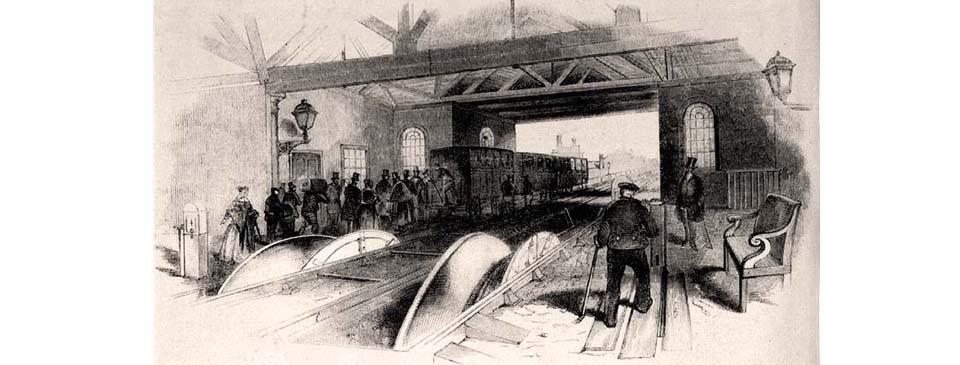The London & Blackwall Railway – one of the capital’s strangest railways

Minories station in about 1840. Passengers board one of the two trains on the line. In the foreground of this illustration the large circular drums can be seen around which the rope that pulls each train is wound.
The total cost of creating the railway was about one million pounds. It opened in July 1840 with a lavish dinner for 1,500 VIP guests. By 1846 10,000 passengers were using the line each day.
Despite the City Corporation’s objections, in 1839 Parliament granted the company the power to extend the line close to Fenchurch Street on the eastern side of the City on the condition that the section between Minories and Fenchurch Street was enclosed. The timing was fortunate for the company because seven years later the Parliamentary Commission on Metropolitan Railway Termini ruled against any further stations in the City and West End.
Opening in July 1841, the Fenchurch Street terminus was a simple structure with only a wooden roof. It was designed by Robert Stephenson and William Tite, while the latter also worked on his design for the Royal Exchange. The area around Fenchurch Street was then a rather insalubrious district. A siding was created at the original Minories station, which was used for freight services. By 1854 it was handling 100 tons of goods daily. The rope was never extended beyond Minories and carriages were left to coast under their own velocity to Fenchurch Street.
The railway company began operating a steamboat service on the Thames from 1841 between Brunswick Pier at Blackwall and Terrace Pier at Gravesend. Initially there were two steamers, the Railway and the Blackwall, which were later joined by the Courier and the Brunswick. For those embarking on ships to take them further afield, or merely seeking a fine whitebait dinner, the Brunswick Hotel was conveniently located close to the Blackwall terminus.
A link to the Eastern Counties Railway between Stepney and Bow, known as the London & Blackwall Extension Railway, was opened in 1849. The ropes, which were continually troublesome and had already been replaced by wires but still without reliability, were then replaced by steam locomotives.
Between 1850 and 1852 a new railway was gradually constructed from a junction at Chalk Farm on the London & Birmingham Railway, joining the London & Blackwall at Poplar via a section of the Eastern Counties. It was half-owned by the London & Birmingham. The line initially went under the grand name of the East and West India Docks & Birmingham Junction Railway but was soon shortened to the North London Railway. Its purpose was to provide passengers with a link between the London to Birmingham line and either the City of London at Fenchurch Street or the docks and Brunswick Pier. Initially much of it ran through open countryside but new stations were opened at Caledonian Road, Victoria Park, and Stoke Newington as those districts were developed with housing.
With trains from other lines then passing along the London to Blackwall, its rail gauge was converted from five feet wide to the standard gauge of 4 feet 8½ inches used by the London & Birmingham and most other railways.
Fenchurch Street station was thereafter shared with the London, Tilbury & Southend Railway, a joint venture between the London & Blackwall and the Eastern Counties, which quickly became the more dominant operator. The number of both trains and passengers travelling into the City increased, so the Fenchurch Street terminus was rebuilt in 1854 largely as it remains today, to the design of George Berkeley, the engineer of the L&SR. Each of the two railways had their own booking office at ground level, with a concourse and platforms at a first-floor level.
The link between the great manufacturing centre of the City of London and the docks proved to be of great value. Within a few years of the line opening large quantities of freight were being transported and six separate goods depots operated by different railway companies were connected to the line on the east side of the City and East End, including Commercial Road, Royal Mint Street at what was previously the Minories station, and a branch to the St. Katharine’s and London Docks. Consequently, the eastern side of the City continued to be a district of warehouses and similar commercial buildings throughout the 20th century.
Branch lines of the London & Blackwall to the Millwall Docks and North Greenwich were added, the latter now being the DLR Island Garden station. The London & Blackwall Railway was merged with the Great Eastern Railway in 1862. It continued as a business until 1923, no longer operational but merely leasing its line to the Great Eastern.
As the eastern suburbs of London expanded over many decades 33 million commuter journeys were being made annually through Fenchurch Street station into the City. The number of passenger services was limited with so many freight trains also using the line, so trains became extremely overcrowded. The situation gradually changed after the opening of the Broad Street terminus, and later Liverpool Street, which served similar parts of the country.
The popularity of steamboats on the Thames diminished during the latter part of the 19th century and thus did passenger traffic at that end of the line, between Stepney and Blackwall. Blackwall Pier station closed in 1926 and between 1953 and 1987 Brunswick Power Station occupied the site. It is now the location of the Virginia Quays development. From 1987 the viaduct section of the former London & Blackwall Railway from Minories to Poplar has been used by the Docklands Light Railway.
Sources include: G.A. Sekon ‘Locomotion in Victorian London’; Christian Wolmar ‘Cathedrals of Steam’; Christian Wolmar ‘The Subterranean Railway’;
Rebecca Preston, Survey of London website https://surveyoflondon.org/map/feature/1284/detail;
‘Disused Stations’ website http://www.disused-stations.org.uk/b/blackwall/;
Isle of Dogs Life’ website https://isleofdogslife.wordpress.com/2016/07/13/the-first-docklands-railway-the-story-of-the-london-and-blackwall-railway/


